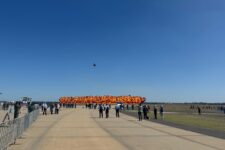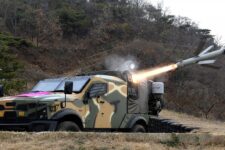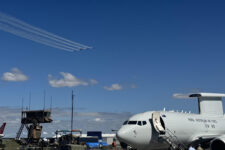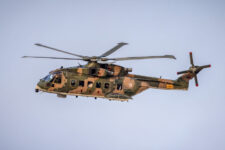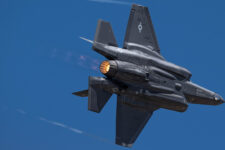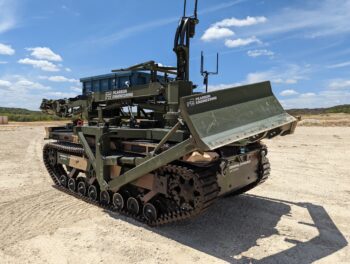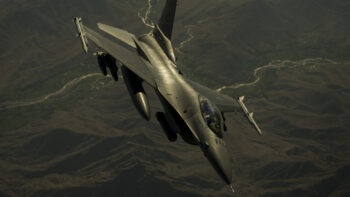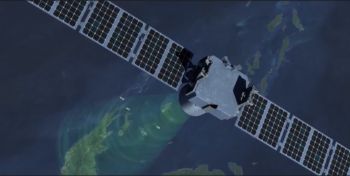
SMC’s Col. Stephen Purdy (left) and his father, retired Col. Stephen Purdy Sr.
WASHINGTON: The Air Force has created a new Special Programs Directorate aimed at “delivering special space capabilities to dominate in war, in, from and through space,” says its head, Col. Stephen Purdy.
Purdy told the AFCEA Space Industry Days 2019 workshop in Los Angeles Oct. 16 that the new directorate — part of Space and Missile Systems Center (SMC) — is a redesign of the former Space Superiority Systems Directorate, “focused on end to end space control,” instead of simply space situational awareness (SSA). Breaking D received a recorded copy of his speech as well his slides.
“We are the integrators of space control,” Purdy said in his slide presentation. He noted that the “number one mission of the directorate is to work across SMC, with the National Reconnaissance Office (NRO), and other mission partners to deliver space warfighting capabilities.”
The shift seems to signal a stronger focus on development of systems for detection, tracking and targeting of enemy spacecraft. Space control in Joint Doctrine refers to both defensive operations (which up to now has included SSA) and offensive counterspace operations (which Air Force officials are loathe to discuss in public.)
Purdy said the new structure reflects Oct. 4 instructions by Gen. Jay Raymond, wearing his Air Force Space Command (AFSPC) commander’s hat, that redefines the SSA mission as “space domain awareness (SDA).” The memo, first obtained by blogger Delta Vees, says: “SDA must be predictive and current and can only be achieved through the dynamic integration of Intelligence, Surveillance and Reconnaissance (ISR), metric observations, and environmental monitoring to execute space battle management and support blue plans and operations.”
The command memo goes on to define SDA as. “The effective identification, characterization, and understanding of any factor, passive or active, associated with the space domain that could effect space operations and thereby impact the security, safety, economy, or environment of our nation.”
Military space leaders for some time have been talking about the SDA concept as a wider vision of SSA, that includes being able to characterize the function of a space object and identify hostile behavior/intent. However, Raymond’s command memo has raised eyebrows among experts both inside and outside DoD.
For one thing, the term SSA is “anchored in Joint Doctrine and the Unified Command Plan.” This means that only the Defense Secretary and the Chairman of the Joint Chiefs of Staff can command that SSA be redefined and a new concept added.
Another concern is that SDA is heavily dependent on the Intelligence Community –which is likely to lead to less transparency — at a time when DoD has committed to loosening classification in order to pursue partnerships with both industry and allies. In fact, a number of senior Air Force leaders have been agitating for more transparency about US military space capabilities and the threats to them in order to strengthen deterrence and public support for the warfighting mission.
Indeed, Purdy said that one of his missions is to “innovate to dominate” SSA, which means encouraging industry partnerships and finding new pathways to speed acquisition of new technologies. One such effort is SMC’s new “marketplace” for vendors of space situational awareness (SSA) products, that Purdy said will open for business by the first quarter of 2021.
It will allow companies to more easily sell to the Pentagon as trusted vendors, but also to buy, sell or become a partner to other companies — a pathway that might make more sense for a Silicon Valley startup, for example.
Philippines cleared to buy F-16s at estimated $5.6B
The approved package, which covers 16 F-16C Block 70/72 jets and four F-16B Block 70/72 fighters, comes just days after Defense Secretary Pete Hegseth visited Manilla and pledged greater defense ties between the two countries.
“Marketplace success hinges on the ability to create advantages for both buyers and sellers,” Purdy said.
To that end, the Special Programs effort is helping to guide a number of startups through “the customer discovery process,” he said, including:
- Space Micro, that has developed a laser communication system for satellite crosslinks and downlinks.
- Swarm Technologies, building a low data rate, low-cost Low Earth Orbit satellite communications constellation.
- Chandah Space, developing tech for persistent SSA in Geosynchronous Orbit.
- Nalu Scientific, producing an ultra low size, weight and power (SWaP) laser warning receiver.
- Roccor, deployable antenna structures for multiple applications
- Dsoft, working with LeoLabs on SDA capability via UHF and S-band radar.
- Spire, building a large constellation for radio frequency collection, that could be plugged into SMC’s new Unified Data Library.
- Braxton Technologies, building a dedicated Enterprise Space Range to support all-domain operations, test and evaluation, and training.
- Nou Systems, developing game-based learning software for training.








